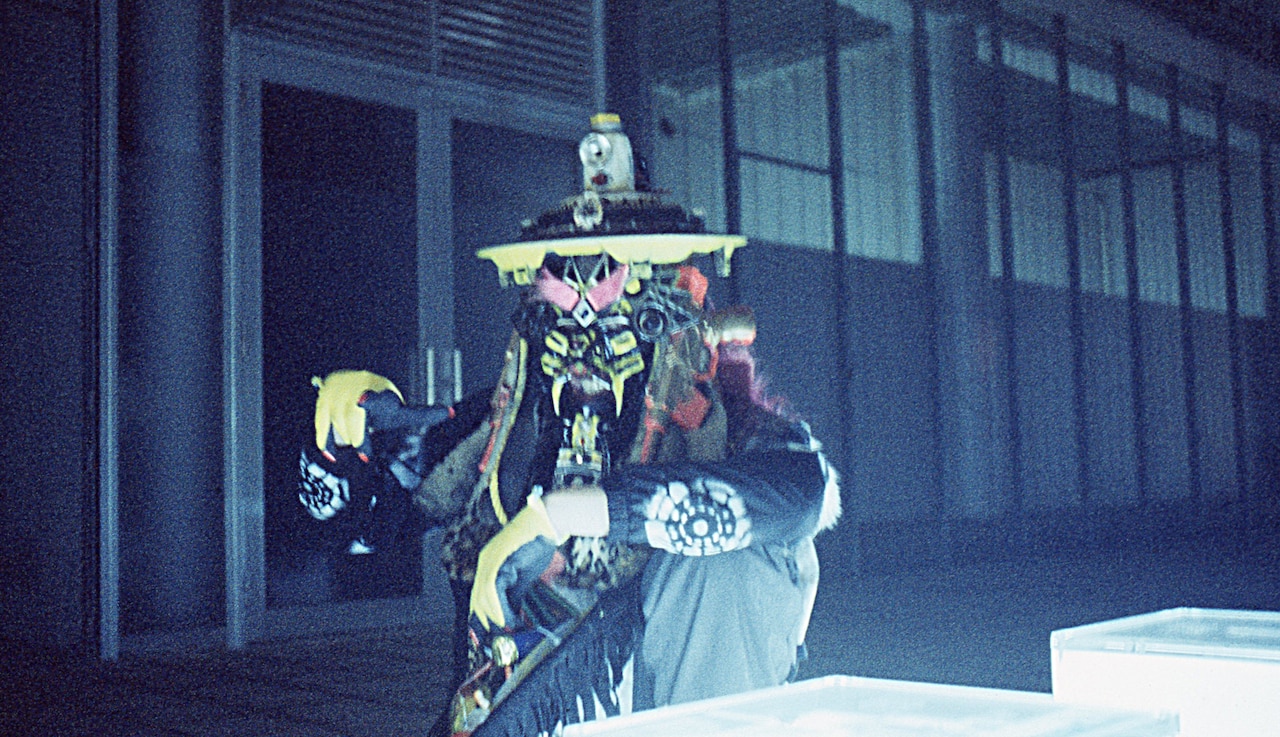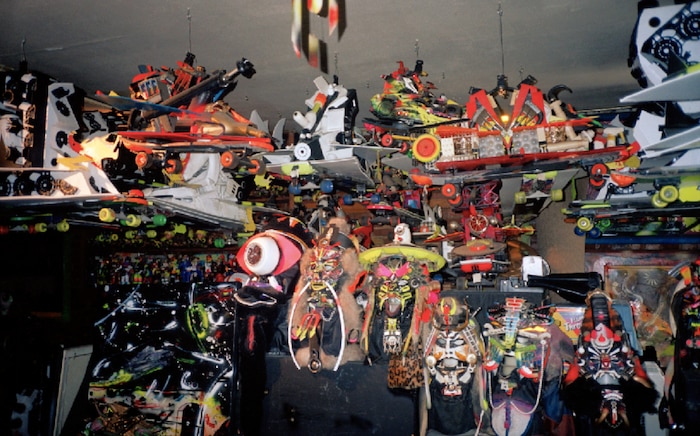The Work of Rammellzee
On the occasion of a career-spanning exhibition at Red Bull Arts New York, Vivian Host speaks to Jeff “Chairman” Mao about the life and craft of the late, great futurist

Rammellzee was a legendary artist, graffiti writer, hip-hop pioneer, Gothic Futurist theoretician and New York City cult icon. From his appearance in Charlie Ahearn’s classic film “Wild Style” to the dense cosmology of his written manifestos and infamously theatrical performances, his work in visual art and music have served as benchmarks for artists pushing the boundaries of creative expression. “Beat Bop” – Rammellzee’s landmark record with fellow graffiti writer/MC K-Rob, produced by Jean-Michel Basquiat – is widely acknowledged as one of the foundational tracks of hip-hop, inspiring the likes of Cypress Hill, the Beastie Boys and RATKING.
In a conversation with Vivian Host on Red Bull Radio’s Peak Time, Jeff “Chairman” Mao of Across 135th Street discusses the life and work of Rammellzee on the occasion of a career-spanning exhibition currently on display at Red Bull Arts New York. RAMMΣLLZΣΣ: Racing for Thunder is the largest survey to date of the influential artist, and will be open through August 28th, 2018.
Tune in to Peak Time weekdays at 12 PM EST on Red Bull Radio.
I’ve been seeing you over the last couple months doing an insane amount of interviews with what seems like every single person who ever hung out with Rammellzee.
Not every single person. There’s a few out there we’re still trying to get, but yeah. I’ve been on the grind, as they say, trying to talk to various people – friends, contemporaries, colleagues, collaborators – who knew this key figure in music and art from New York City. It’s been a wild ride, as befits the figure Rammellzee.
A lot of people have probably at one point or another seen a picture of Rammellzee, because he was prone to wearing these wild, futuristic outfits, mostly of his own design, kind of looking like a Japanese feudal warrior/futuristic b-boy.
Kind of a combination of all those things. He started out in the late ’70s, early ’80s in the New York City hip-hop scene, like a lot of kids, and was writing on trains and tagging up trains and bombing and whatnot. Through that, [he] actually kind of transcended hip-hop in a more traditional sense, and became a fine artist, had his work displayed overseas extensively and then created these amazing costumes which you made reference to, some of which he would perform in.
If you go online, you can probably find some vintage footage of Ramm donning these super elaborate, heavyweight costumes. Some of these outfits would have rockets on them and would just spontaneously fire off during performance. There are actually some funny stories about the fireworks not always going in a safe place. That’s definitely a part of his legacy. In terms of performers, especially in the hip-hop realm, you can look at people like MF Doom and probably draw a line between what Ramm was doing and what they do now.
Who were some of the people that Ramm would have been hanging out with, kind of in the early days when he was first writing graffiti, when this persona was just starting to evolve?
Well, Rammellzee is originally from Far Rockaway, Queens, and spent time in the local scene out there with people like the graph writer Sonic and Shockdell, who’s an MC that he performed with in the film Wild Style. Then at a certain point he came to Manhattan, spent a lot more time in the city and was hanging out in the downtown art scene here with folks like Lee Quiñones, Fab Five Freddy, as well as his own crew, called the Tag Master Killers, which was A1, Arbitrator KOOR and Toxic.
Those were kind of his immediate, some of his more famous people that he hung out with as well as his immediate circle. Through some of those connections, he met Jean-Michel Basquiat in downtown NYC at the time. They became kind of, I don’t know how to put it. I guess “friends,” but “muses” in some respects. He collaborated with Basquiat and a writer named K-Rob, who used to write Crane, the graffiti artist, and he was an MC as K-Rob. They did a record that Basquiat produced, called “Beat Bop,” which became one of the most important experimental hip-hop records of all time, very influential and still sounds good today.
Essentially, he viewed graffiti culture, wild style, lettering on the side of a train, as having its antecedent hundreds of years earlier.
What year is “Beat Bop” from?
1983, I believe.
Wow, so really early on.
It’s pretty early. Basically Basquiat was doing his band Gray, which was kind of this abstract, downtown, art-noise group, with Nick Taylor and Michael Holman. After that broke up, he wanted to try his hand producing a hip-hop record, because he was fascinated with this culture that was burgeoning, was coming up from New York City boroughs at the time.
These guys represented – meaning Ramm and K-Rob and Ramm’s crew – these guys represented a different part of the street art scene, a different type of experience that was going on in New York City at the time. They came in and did this record, and it’s a pretty fascinating record. You have K-Rob basically rhyming a character, like a kid coming home from school, talking about, like, Grandmaster Flash, “The Message”-type of rhyme. “This is going on in the city, there’s all these social ills,” etc…
Rammellzee just comes in and does a freestyle, essentially, that is him as the pimp on the corner, the guy with this incredibly charismatic style to him, and this crazy voice, this crazy cadence, and he just makes being a street dude, being a gangster, whatever have you, just sound really seductive, because he was able to adopt that theatricality and performance style.
We were mentioning that Rammellzee is in Wild Style and a lot of these kind of famous New York graffiti movies.
He’s in Wild Style. He performs in the musical finale of the film, along with Shockdell, one of his rhyme partners. He’s also in Style Wars, Tony Silver and Henry Chalfant’s graffiti documentary. He’s not on-screen, on-screen, but his voice is definitely the MC voice in the United Skates of America scene with Rock Steady Crew. There’s a half-frame flash of him, earlier in the movie, for all the Rammellzee nerds. He’s in both films actually, so it’s kind of cool.
So he was legit a part of it, although what we were hearing on “Beat Bop,” that was a pretty psychedelic track.
I love that track, I think it’s just so cool. His voice is this crazy instrument. He called his cadence the gangster duck style. It’s got kind of like a W.C. Fields, almost [voice], super nasal. He was just very, very unique for, I guess, any era, but particularly that era. Charlie Ahearn, the director of Wild Style, I was talking to him the other day and he had said how Ramm didn’t fit in to what dudes in the Bronx were doing in terms of their rhyme style, their ability, their cadence, how they control the audience, how they move the crowd. They had certain go-to types of call-and-response, whatever. Ramm just flowed in an entirely different way.
I think everything, almost everything he wrote was essentially… He didn’t really write, he was kind of just going off the head. You can kind of tell in “Beat Bop,” it’s totally off the head; amazing combination of a lot of things happening in that track. It’s got a violin in it ... Eszter Balint, who was in the film “Stranger Than Paradise,” she’s the female star of that Jim Jarmusch film. Classic ’80s, New York City independent film. She plays the violin on that. Al Diaz, who was Basquiat’s partner in SAMO, the street art stuff they were doing when they were high school kids, he plays percussion on “Beat Bop.” It’s kind of this incredible amalgamation of different essential figures, just having fun, just doing something kind of wild in the studio. I think it was just thought of as a side project. There was so much cool stuff going on at that time. Al was like, “Yeah, we didn’t think anything about this, it was just something to do.” Here it is, we’re still listening to it, X number of years later.
It’s so cool when you think back, or when you look at the credits on some projects from that time in New York City, it really gives you the sense that so many people from different backgrounds and different kind of métiers, if you will, were collaborating. I wanted to talk to you a little bit about Gothic Futurism, which is sort of Rammellzee’s principles. Tell me more about what this is, and what he was thinking about or writing about when he came up with this.
I will preface this by saying I am not entirely 100% comfortable being an interpreter of Gothic Futurism, but Gothic Futurism and Ikonoklast Panzerism were sort of the dual sets of laws, principles that guided all of Rammellzee’s work.
He basically, as far as I can tell, if you met Ramm, he would basically speak in terms of these ideas, these laws, and he was 1,000% committed to them. It was like, there was no debate about what this stuff meant to him, and how important it was. Essentially, he viewed graffiti culture, wild style, lettering on the side of a train, as having its antecedent hundreds of years earlier. Basically, if you go back to ancient monks doing calligraphy, persecuted by the Catholic church for not being able to write in a way that was legible to them; that was the equivalent of what kids were doing on trains in New York City in the ’70s and ’80s. He viewed all of this as an important extension of thing that have been going on for ages. Essentially, letter formations were at the heart of this. The letter had been taken and corrupted, taken from its Phoenecian beginnings and corrupted into languages that were diseased, basically.
It was important to arm the letter, literally. If you were rendering the letter, you had to make this letter be able to ward off foes and enemies. It’s very militaristic, I guess, combative.
That’s what Ikonoklast Panzerism is. Essentially, this notion of how you design letters, but make them, you reclaim them and you make them weapons, you weaponize letter formations. In Ramm’s work, what you have are these sets of what he called letter racers, which are essentially his renderings of the letters of the traditional alphabet, but in these… He’ll probably be mad saying “abstract,” cause it’s not abstract to him, it’s all science. These renderings that are 3D, they become these sculptures.
If you went to his crib, the Battle Station, his studio down on Laight Street by the Holland Tunnel, you would walk in and see these things suspended in battle formation, from the ceiling, like a fleet. There were different sets of them, so there’s at least gonna be two sets that are gonna be on display in exhibition at the RAMMΣLLZΣΣ: Racing for Thunder gallery show, in addition to a bunch of the other works. As best as I feel comfortable, sort of explaining Gothic Futurism and Ikonoklast Panzerism, that’s what I got for you.

It really makes you think about him being one of these figures that actually took graffiti and took b-boying and these things that people might have seen in the street, and kind of, not gave them a spin, but basically explained to people how these were art forms and important and had a backstory.
They weren’t novelties.
The letters have a meaning, and the shapes have a meaning, and all these things have a deeper essence than just like, “Hey, this is a kid writing on a train.”
Yeah, I think that’s the thing. What’s the traditional narrative that’s always gonna come through, there can only be one special person from the streets or whatever. I think that’s part of why Basqiuat’s been championed. He’s a brilliant artist, but then it’s like, at the expense of whatever else was going on. Rammellzee represents something extremely sophisticated in terms of thought, in terms of how the art form fits in in a broader way. He’s just this amazing character who’s just full of mystique and mystery, because he didn’t share a lot of personal information. Which is part of what we’re doing, is trying to get this personal information, but also uphold the mystique.
It’s like, who were the people that mentored Ramm? Where did he come up with these ideas? How did he get to this point? That’s kind of the quest that we’re on, and hopefully that’s the stuff that we can shed a little bit of insight into. But also, hopefully these are the things that people are also intrigued by. I think that they are, which is why people are still interested in Rammellzee today, because he’s still… what is it, question mark, wrapped in an enigma, whatever.
Encrusted in a riddle.
Encrusted in a riddle, illegible in Ikonoklast Panzerism.
What’s one thing you discovered about Rammellzee that you didn’t really know before?
He went to dentistry school. He attended high school, studied dentistry at some point. Just trying to piece together these little facts, factoids about his life. There’s a science to everything he’s done, and I think that’s just really the fascinating part of it, is figuring out, as basically a self-taught individual, where he gleaned some of these morsels of knowledge from. Not to say that it has to come from a book or come from a class or anything like that, ’cause a lot of this brilliance is just in him as an individual, just piecing these little interesting things together. If you see this picture of him and Basquiat on one of the LA trips, which I think maybe that Rhythm Lounge freestyle is from, there’s a very famous photo by Stephen Torton, where they’re outside of Disneyland at dawn. They’re going to Disneyland, they just both are looking like the cool… you know what’s that they are. You know what I mean... with the long coats and they’re just living it, you know what I mean?
Ramm had the crazy outfit with the rocket launcher, and the rocket just fired off into the crowd and it singed this lady’s hair, who was the wife of some super high-end art collector.
I don’t want to reduce Ramm’s career to the early ’80s, because obviously it extends well, well beyond that, and he did some of his greatest stuff after that. But just getting a peek into these moments has been really fun. The influence still pervades today, I think. Even though it’s decades removed and he passed away in 2010, I think that the influence is still here with people. It’s tougher to glean, because people have to be really inquisitive and want to know. But there’s different musical groups now who have taken inspiration from him, whether it’s Letter Racer Crew in New York City, Actress sampled his voice from that Rhythm Lounge freestyle from one of the tracks off his album last year. And this whole sort of idea of bringing this emphasis on theatricality to performance.
You’re asking me if there’s a funny story. I made passing reference to it before, but I think Shoe, one of the graffiti writers from the Netherlands, was telling me he went to one of these shows back in the day and Ramm had the crazy outfit with the rocket launcher, and the rocket just fired off into the crowd and it singed this lady’s hair, who was the wife of some super high-end art collector. And it wasn’t even like anybody noticed what was going on. The rapping is still going, this cacophonous beat is still going, whatever. And it’s just like, that kind of epitomizes it in a way. It’s like, this man...he’s wreaking havoc in some ways. There’s incredible beauty in it, and it just keeps going on and he’s himself and he’s just doing it and he’s probably still doing it wherever he is now.
Even though Ramm considered himself a gothic futurist, I think he definitely fits in the Afrofuturist tradition. I used to see him around when I first moved to New York, in 2004. He would sort of be at certain gallery shows or certain events. And I always just felt like he was a guy that was getting messages from the ancestors, getting messages from the aliens. He seemed to sort of have distilled these influences from all around time into his look, into his work, into his visual arts. And it was kind of amazing. Like you said, it’s not stuff that is necessarily taught in a school. It’s like an amalgamation of everything he had lived, read, gotten a message from outer space.
He’s working on a whole other level, for sure. Even Charlie and Henry both told me that they both saw letters from the Defense Department. Ramm had written to the Defense Department, basically offering use of his design that would protect the earth from alien intervention. And they both kindly declined. But they saw the rejection letter from the Defense Department. Al Diaz has called him the Sun Ra of Graffiti Culture. That sounds about right too.

